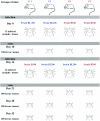Interaction and transmission of two Borrelia burgdorferi sensu stricto strains in a tick-rodent maintenance system
- PMID: 15528545
- PMCID: PMC525125
- DOI: 10.1128/AEM.70.11.6783-6788.2004
Interaction and transmission of two Borrelia burgdorferi sensu stricto strains in a tick-rodent maintenance system
Abstract
In the northeastern United States, the Lyme disease agent, Borrelia burgdorferi sensu stricto, is maintained by enzoonotic transmission, cycling between white-footed mice (Peromyscus leucopus) and black-legged ticks (Ixodes scapularis). B. burgdorferi sensu stricto is genetically variable and has been divided into three major genotypes based on 16S-23S ribosomal DNA spacer (RST) analysis. To better understand how genetic differences in B. burgdorferi sensu stricto may influence transmission dynamics in nature, we investigated the interaction between an RST1 and an RST3 strain in a laboratory system with P. leucopus mice and I. scapularis ticks. Two groups of mice were infected with either BL206 (RST1) or B348 (RST3). Two weeks later, experimental mice were challenged with the opposite strain, while control mice were challenged with the same strain as that used for the primary infection. The transmission of BL206 and B348 from infected mice was then determined by xenodiagnosis with uninfected larval ticks at weekly intervals for 42 days. Mice in both experimental groups were permissive for infection with the second strain and were able to transmit both strains to the xenodiagnostic ticks. However, the overall transmission efficiencies of BL206 and B348 were significantly different. BL206 was more efficiently transmitted than B348 to xenodiagnostic ticks. Significantly fewer double infections than expected were detected in xenodiagnostic ticks. The results suggest that some B. burgdorferi sensu stricto strains, such as BL206, may be preferentially maintained in transmission cycles between ticks and white-footed mice. Other strains, such as B348, may be more effectively maintained in different tick-vertebrate transmission cycles.
Figures


Similar articles
-
Duration of Borrelia burgdorferi infectivity in white-footed mice for the tick vector Ixodes scapularis under laboratory and field conditions in Ontario.J Wildl Dis. 1997 Oct;33(4):766-75. doi: 10.7589/0090-3558-33.4.766. J Wildl Dis. 1997. PMID: 9391960
-
Closely-related Borrelia burgdorferi (sensu stricto) strains exhibit similar fitness in single infections and asymmetric competition in multiple infections.Parasit Vectors. 2017 Feb 6;10(1):64. doi: 10.1186/s13071-016-1964-9. Parasit Vectors. 2017. PMID: 28166814 Free PMC article.
-
Interference between the agents of Lyme disease and human granulocytic ehrlichiosis in a natural reservoir host.Vector Borne Zoonotic Dis. 2001 Summer;1(2):139-48. doi: 10.1089/153036601316977741. Vector Borne Zoonotic Dis. 2001. PMID: 12653144
-
The role of Ixodes scapularis, Borrelia burgdorferi and wildlife hosts in Lyme disease prevalence: A quantitative review.Ticks Tick Borne Dis. 2018 Jul;9(5):1103-1114. doi: 10.1016/j.ttbdis.2018.04.006. Epub 2018 Apr 16. Ticks Tick Borne Dis. 2018. PMID: 29680260 Review.
-
Rodent-targeted approaches to reduce acarological risk of human exposure to pathogen-infected Ixodes ticks.Ticks Tick Borne Dis. 2023 Mar;14(2):102119. doi: 10.1016/j.ttbdis.2023.102119. Epub 2023 Jan 14. Ticks Tick Borne Dis. 2023. PMID: 36680999 Free PMC article. Review.
Cited by
-
Competition between strains of Borrelia afzelii in the host tissues and consequences for transmission to ticks.ISME J. 2021 Aug;15(8):2390-2400. doi: 10.1038/s41396-021-00939-5. Epub 2021 Mar 3. ISME J. 2021. PMID: 33658621 Free PMC article.
-
Variation among strains of Borrelia burgdorferi in host tissue abundance and lifetime transmission determine the population strain structure in nature.PLoS Pathog. 2023 Aug 22;19(8):e1011572. doi: 10.1371/journal.ppat.1011572. eCollection 2023 Aug. PLoS Pathog. 2023. PMID: 37607182 Free PMC article.
-
Characterization and genomic analysis of the Lyme disease spirochete bacteriophage ϕBB-1.PLoS Pathog. 2024 Apr 1;20(4):e1012122. doi: 10.1371/journal.ppat.1012122. eCollection 2024 Apr. PLoS Pathog. 2024. PMID: 38558079 Free PMC article.
-
Fitness variation of Borrelia burgdorferi sensu stricto strains in mice.Appl Environ Microbiol. 2008 Jan;74(1):153-7. doi: 10.1128/AEM.01567-07. Epub 2007 Nov 2. Appl Environ Microbiol. 2008. PMID: 17981941 Free PMC article.
-
Borrelia burgdorferi promotes the establishment of Babesia microti in the northeastern United States.PLoS One. 2014 Dec 29;9(12):e115494. doi: 10.1371/journal.pone.0115494. eCollection 2014. PLoS One. 2014. PMID: 25545393 Free PMC article.
References
-
- Baranton, G., D. Postic, I. Saint Girons, P. Boerlin, J. C. Piffaretti, M. Assous, and P. A. Grimont. 1992. Delineation of Borrelia burgdorferi sensu stricto, Borrelia garinii sp. nov., and group VS461 associated with Lyme borreliosis. Int. J. Syst. Bacteriol. 42:378-383. - PubMed
-
- Baranton, G., G. Seinost, G. Theodore, D. Postic, and D. Dykhuizen. 2001. Distinct levels of genetic diversity of Borrelia burgdorferi are associated with different aspects of pathogenicity. Res. Microbiol. 152:149-156. - PubMed
-
- Beati, L., and J. E. Keirans. 2001. Analysis of the systematic relationships among ticks of the genera Rhipicephalus and Boophilus (Acari: Ixodidae) based on mitochondrial 12S ribosomal DNA gene sequences and morphological characters. J. Parasitol. 87:32-48. - PubMed
-
- Burgdorfer, W., A. G. Barbour, S. F. Hayes, J. L. Benach, E. Grunwaldt, and J. P. Davis. 1982. Lyme disease—a tick-borne spirochetosis? Science 216:1317-1319. - PubMed
-
- Canica, M. M., F. Nato, L. du Merle, J. C. Mazie, G. Baranton, and D. Postic. 1993. Monoclonal antibodies for identification of Borrelia afzelii sp. nov. associated with late cutaneous manifestations of Lyme borreliosis. Scand. J. Infect. Dis. 25:441-448. - PubMed
Publication types
MeSH terms
Grants and funding
LinkOut - more resources
Full Text Sources
Medical

